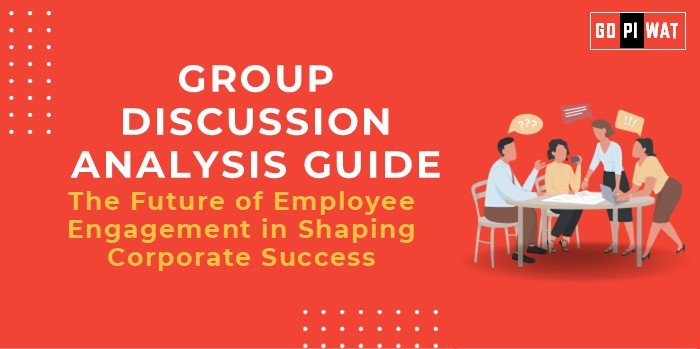📋 Group Discussion Analysis Guide
🌟 The Future of Employee Engagement in Shaping Corporate Success
🌐 Introduction to the Topic
- Opening Context: “In the evolving global corporate landscape, employee engagement has emerged as a cornerstone for driving productivity, retention, and innovation.”
- Topic Background: Employee engagement refers to the emotional commitment employees have toward their organization. Post-pandemic shifts to hybrid work, evolving workplace expectations, and technological advancements are reshaping the meaning and practices of engagement.
📊 Quick Facts and Key Statistics
- 💸 Employee Disengagement Cost: $8.8 trillion annually to the global economy (Gallup, 2023).
- 📉 Engagement Levels: Only 23% of employees worldwide are actively engaged at work (Gallup, 2023).
- 🌐 Hybrid Work Impact: 83% of employees prefer a hybrid model, emphasizing flexibility as key to engagement (Microsoft Report, 2023).
- 📈 Retention and Engagement: Companies with high employee engagement see 21% higher profitability and 41% lower absenteeism (Forbes, 2023).
- 🤖 AI and Engagement: 65% of HR leaders believe AI tools will redefine employee engagement strategies.
👥 Stakeholders and Their Roles
- Corporate Leaders: Strategize and implement engagement policies to align employee goals with organizational vision.
- HR Departments: Drive policies on well-being, communication, and professional growth.
- Employees: Proactively engage in organizational culture and align with company values.
- Technology Providers: Develop digital platforms, like AI-driven tools, to monitor engagement and employee satisfaction.
- Government and Policymakers: Define labor laws promoting work-life balance and flexible work arrangements.
🏆 Achievements and Challenges
🌟 Achievements
- Productivity and Profit Gains: Organizations with highly engaged teams report a 23% increase in profitability.
- Technological Integration: Platforms like Slack and Microsoft Teams foster better communication and collaboration in remote setups.
- Employee Well-being Programs: Organizations prioritizing mental health see a 25% improvement in retention rates.
⚠️ Challenges
- Hybrid Work Disconnection: Physical separation often reduces emotional attachment and workplace camaraderie.
- AI-Driven Monitoring Backlash: Excessive surveillance undermines trust among employees.
- Generational Diversity: Aligning engagement strategies across Gen Z, Millennials, and Boomers poses unique challenges.
🌍 Global Comparisons
- USA: Employee recognition programs like “Great Places to Work” drive higher retention rates.
- Germany: Strong policies on work-life balance foster higher productivity and lower burnout levels.
📚 Case Study
Unilever: Implemented “Agile Working” policies, providing flexibility and achieving a 25% increase in employee satisfaction and retention rates.
🗣️ Structured Arguments for Discussion
- Supporting Stance: “Employee engagement is directly linked to higher organizational success, boosting productivity, retention, and innovation.”
- Opposing Stance: “Engagement initiatives often lack measurable outcomes, and the focus can shift from meaningful tasks to superficial programs.”
- Balanced Perspective: “While engagement initiatives are essential for success, they need a customized, data-driven approach to be effective across diverse organizations.”
🎯 Effective Discussion Approaches
🌟 Opening Approaches
- Statistical Impact: “Disengaged employees cost companies $8.8 trillion globally, emphasizing the urgent need for improved engagement strategies.”
- Contrast Approach: “While 83% of employees value flexibility, many organizations still struggle to balance productivity and employee satisfaction.”
⚡ Counter-Argument Handling
Acknowledge challenges: “Monitoring tools can undermine trust if poorly implemented.”
Offer solutions: “Transparent communication and employee feedback loops can address these issues effectively.”
🔍 Strategic Analysis of Strengths and Weaknesses
SWOT Analysis
- Strengths: Proven productivity gains; flexibility and work-life balance tools.
- Weaknesses: Risk of employee burnout; technology-driven disconnection.
- Opportunities: AI and data analytics for customized strategies; building purpose-driven work environments.
- Threats: Resistance to change from senior leadership; lack of employee trust in monitoring systems.
🎓 Connecting with B-School Applications
📚 Real-World Applications
- Operations Management: Case studies on productivity enhancement through engagement tools.
- Leadership Programs: Strategies to foster emotional intelligence in team management.
❓ Sample Interview Questions
- “How can organizations adapt their engagement strategies for a hybrid workforce?”
- “What role does technology play in improving employee engagement without compromising trust?”
💡 Insights for B-School Students
- Leverage engagement theories to design innovative workplace solutions.
- Explore AI-driven platforms to analyze and predict employee satisfaction trends.


